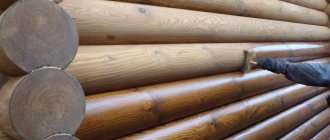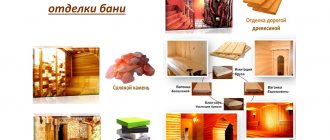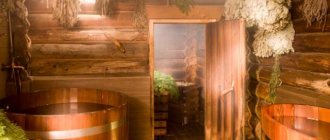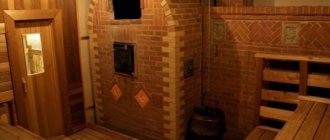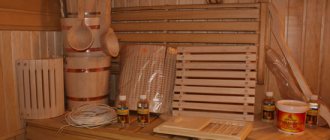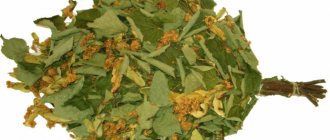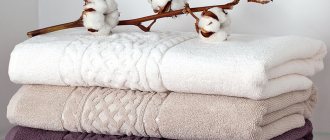- Oil purification
To protect and improve the performance characteristics of wood in a bathhouse, it is coated with antiseptic compounds. They also contribute to the long-term preservation of the aesthetic appearance of the material. And if auxiliary rooms or the outer surface can be treated with chemicals, then only natural ingredients are used to impregnate the shelves, walls, floor and ceiling in the steam room itself. One of the most common is flaxseed oil.
Why is there impregnation in the bath?
Since wood is a natural and absolutely safe material, it is often used for interior decoration. But at the same time, it strongly absorbs moisture, as a result of which the surface becomes loose and is an excellent habitat for microorganisms, in particular fungi. Bacteria that have settled in wooden cladding through their vital activity provoke deterioration of the material and the collapse of the structure.
The market offers a fairly wide range of impregnations for saunas and baths, which are capable of creating a coating that protects the casing from the destructive effects of high humidity and temperature changes. In addition, they have excellent antiseptic properties. The undeniable advantage of such products is the ability to give the surface an attractive appearance, performing the function of a decorative finish.
Note! When choosing impregnation for baths and saunas, you should give preference to products that do not emit toxic substances.
Antiseptic impregnation for a bath allows you to extend the service life of the internal lining, preserve its appearance, and protect it from rotting and mold. These are unique products that do not form a film on the surface of the wood and do not prevent it from breathing.
Indications for insulation
Door insulation serves several purposes:
- First of all, this is to prevent heat loss. The bathhouse is especially susceptible to heat loss. It is always very hot in the steam room, and in winter, with a sufficiently large temperature difference, heat loss increases significantly.
- Protecting the door from drying out and rotting. A simple wooden door will begin to increase and decrease in size under varying humidity conditions. This will affect the door frame. As a result, situations often occur when the door simply stops closing or opening, and mold forms on the surface of the door leaf
- A big problem with wooden doors is drafts. Especially above the floor of a steam room without door insulation, a cold breeze will always be felt. This is unlikely to result in illness, but it will certainly ruin your vacation in the steam room.
It is necessary to insulate the doors in the bathhouse when there is heat loss.
Therefore, it is definitely necessary to insulate the door to the bathhouse. To simplify the process, the door to the steam room and the dressing room are insulated according to the same scheme.
What to choose
Specialized retail outlets offer a huge number of impregnations for wooden surfaces; they differ in use, form, and composition.
Before you make a purchase of one or another protective equipment, it is recommended to clearly determine what tasks it should cope with, namely:
- what surface will be treated (floor, ceiling, benches, shelves in the steam room, the entire room);
- will an additional decorative coating be used or will the surface after treatment remain the same as before;
- will the degree of moisture protection inside the bath be sufficient;
- Is the application method convenient?
An essential indicator of high-quality impregnation for baths, including those made from logs, is the combination of its moisture-proof properties with the ability not to prevent the skin from breathing. Since the presence of film leads to blockage of the wood structure and subsequent problems leading to damage to the surface. It is also worth paying attention to the environmental friendliness of the selected antiseptic. Otherwise, low-quality goods at high temperatures and high levels of humidity in the room will release harmful substances.
If impregnation is selected for treating floors, then after its application there should not be a slippery coating. Tabletops and benches should be treated with products designed for regular wet cleaning. There are shelf impregnations on sale that can completely penetrate the wood structure and prevent the formation of burns on the body at high temperatures.
Option with additional wooden frame
Materials you need to prepare:
- wooden beams 20 x 20 mm;
- insulation;
- aluminum and construction nails with heads or self-tapping screws;
- sheet of fiberboard or wooden plywood.
For ease of operation, the bath door must be removed and laid on a flat, solid base.
Wooden blocks must be nailed along the entire perimeter of the canvas, so that their edges protrude beyond the boundaries of the existing canvas by 10-15 mm. Using aluminum nails, it is necessary to nail the insulation onto the frame, folded in half so that it protrudes beyond the edges of the frame by 10-15 mm.
The mechanism of action of this design is that the door itself becomes warmer, and when closed, additional sealing is provided due to the insulation bent outward, nailed with an overlap.
Laying insulation into the inner chamber
If the bathhouse has a three-dimensional door, then it must have insulation in its cavity. If cold drafts appear in the bathhouse, the insulation must be replaced. In all likelihood, it has fallen into disrepair. To do this, the door removed from its hinges must be disassembled and the old insulation removed from its cavity. Having laid the new material, the canvas must be re-assembled and installed in place. All wooden parts must fit very tightly to each other, and there must be an air gap in the cavity of the canvas.
Kinds
Protective impregnations for wooden surfaces are divided into groups depending on the main component in their composition, as well as on the properties and method of application. According to the form of release, antiseptics are:
- aerosol;
- gel;
- in the form of a solution.
All types of impregnations for baths and saunas have water-repellent properties. Modern impregnations for baths rarely have only one function; they can often be used as universal preparations that can also protect wooden surfaces from the negative effects of elevated temperatures, excessive humidity and from damage by pathogenic microorganisms and harmful insects.
Based on their composition, the products are divided into water-soluble and oil-based. You can purchase a combined product in the form of varnish and paint, which is characterized by the effect of moisture protection and prevention from microorganisms. Most impregnations have additional performance qualities in the form of fire resistance and dirt-repellent function.
How to treat the floor and shelves: varnish coatings in the steam room
How to paint the shelves in the bathhouse and can I use varnish for this? Of course it is possible. However, not any varnish coating is suitable for shelves, and even more so for a steam room in a bathhouse.
Important! The safest are acrylics from the company Tikkurila, already known to us.
They are made on a natural basis, and the finished product is heat-resistant, as well as a fairly large selection of colors and shades.
Before painting the lining in a bathhouse with varnish, you should familiarize yourself with its main advantages and disadvantages.
The advantages include:
- Antiseptic in the composition, so before coating it is not necessary to use additional substances to prepare the surface;
- The film formed on the varnished surface does not allow moisture to pass into the wood;
- The varnish coating does not lose its properties even at temperatures above 100 degrees;
- An abundance of colors from which you can choose the one that suits you, or use clear varnish.
You should apply the varnish responsibly.
The first step is to sand the surface of the shelf. This should be done starting with the largest nozzle and ending with the smallest.
Attention! The smallest nozzle performs a polishing role.
After polishing the shelves, wipe them with a damp cloth to remove any remaining sawdust, dust and dirt. Once the wood has dried, you can begin applying varnish. To do this you need to use a brush or roller.
It is very important to ensure that each part is coated with varnish. For hard-to-reach areas, we recommend using a thin brush or sponge.
Information. In order not to make a mistake with the choice of colored varnish, it is first recommended to apply it to a small area in two layers to finally make sure that your choice is correct.
Differences between oil and water soluble products
The main distinguishing feature of water-soluble impregnations is the base on which they are made - acrylic. An additional component of the product is usually a special coloring color, which gives the treated sauna lining a certain shade. Acrylic impregnations with varnish are now very popular. They are used to treat baths inside and outside.
Despite the many positive characteristics of acrylic preparations, they have one drawback - gradual leaching from the wood structure. To maintain the natural cladding, it is necessary to carry out regular treatments. An excellent solution to this problem would be to first coat the surface with a waterproofing solution and then with bath impregnation. With such an integrated approach, the wood will last much longer.
Due to the absence of color and odor in acrylic, such preparations are especially suitable for interior work. This is a good option for those owners of baths and saunas who want to preserve the natural wood grain. On sale, water-soluble products are presented in the form of dry mixtures or ready-to-use solutions.
Oil impregnations are distinguished by their ability to penetrate deeply into the wood base, leaving a thin film on the outside. They are characterized by durability and can maintain their performance much longer, even at excessive levels of humidity, than water-soluble preparations.
Oil impregnations are characterized by a high degree of toxicity and the presence of an unpleasant, pungent odor, since they contain a solvent. Due to their toxicity, it is not recommended to use these substances indoors without following safety regulations. They can be used to treat the dressing room, outside walls, and utility rooms.
Paint selection
Today, the choice of product for painting wooden doors is very wide. Therefore, deciding on a specific option will be quite difficult. First of all, you should decide what the owner expects as a result: he wants to preserve the original texture of the wood or wants to completely destroy the natural pattern. Therefore, all paints can be divided into two large groups:
- Opaque enamels and coloring compounds. These can be oil, acrylic, alkyd, polyurethane or perchlorovinyl paints.
- Clear or tinted varnishes. Such compositions include varnishes with a tinting effect, stains, and oil impregnations that can simply refresh the natural grain of wood.
The choice depends on the personal preferences of each person, but experts recommend preferring the following type of product:
- Acrylic dyes that are water based. Such paints have their advantages, first of all, ease of use, since the compositions are easy to apply with a brush, dry quickly and are not inferior in their technical characteristics to oil analogues.
- Alkyd compounds, which have high water-repellent properties, perfectly withstand temperatures and external environmental influences.
For a bathhouse, it is best to use the latest options; they are suitable for painting both interior and exterior doors.
Processing different parts of the bath
Conditions in different parts of the bathhouse are different, therefore the requirements for finishing materials are different. In rooms where temperature and humidity are maintained at high levels, it is recommended to choose more expensive durable impregnations.
Waiting room
Among the most popular ready-made products are Sauna (Belinka) and Supi Saunasuoja (Tikkurila). Of the domestic impregnations, the U-409 remedy has proven itself well. It can be equally effectively used for processing wooden structures in baths, saunas, bathrooms, showers and living spaces. All these impregnations are made using only natural ingredients. After their application, a thin film is formed on the sheathing (eurolining) and logs, which greatly simplifies the removal of contaminants. They contain fungicidal and insecticidal components that help prevent the appearance and proliferation of pathogenic microorganisms in baths and saunas, which is especially important for the dressing room.
Another well-known antiseptic is Eurotex Sauna, which contains wax. A colorless wax antiseptic creates a protective film on the surface of a wooden structure. The product is excellent for treating benches and shelves. Impregnation volume of 2.5 liters is enough for 35 sq. m. After using this product, wood has a more attractive appearance, is easier to clean and retains its original color for a long time. The only drawback that can be noted is the presence of a clear specific smell inside the room, but after 3-5 visits it disappears.
Steam room
Considering that the air temperature and high humidity inside the steam room are very high, a special approach is needed here, in particular, you should know how best to treat the lining in the steam room. Natural oils and wax are suitable for these purposes. Some home craftsmen impregnate the boards with linseed oil with the addition of a natural aromatic composition. Often, from a variety of oils, hemp oil is chosen for impregnation. If you need a more economical option, you can use refined sunflower oil.
There is a fairly large selection of products for treating industrial shelves. These are impregnations from Russian and Eurotex Sauna, and Supi Laudesuoja oil from Tikkuril.
Note! It is not advisable to use ordinary paints and varnishes to protect benches, joists, shelves, walls and ceilings.
Wooden surfaces must breathe - first absorb moisture and then release it. If conventional compositions are used, then such surfaces lose this quality. In addition, in conditions of high humidity and high temperatures, the evaporation of harmful substances that pose a health hazard is added, and the bathhouse no longer becomes a cure for many diseases, as it has been for centuries. This can be compared to finishing a bathhouse or sauna with linoleum or siding, which is strictly contraindicated.
Insulation for a bathhouse door with your own hands - thermal curtain
A thermal curtain will help to effectively ensure thermal insulation of the dressing room.
Make a sealing frame on the inside of the door block. Cut the insulation into strips (2 strips measuring 10 cm * 100 cm and 2 strips 10 cm * 200 cm are enough). Nail them along the perimeter of the door frame 2 cm from the edge, placing them towards the door.
With a standard door size, nail wooden blocks on top of the insulation: two measuring 2x2x184 cm, and two measuring 2x2x80 cm. Wrap them with strips of insulation, cutting off its excess and press it on three sides with cash.
From thick fabric, tarpaulin or leatherette, make a continuous screen measuring 120 * 200 cm. On one side, sew it along the entire height so that a block measuring 2x2x200 cm fits inside this flap.
The other side must be attached to the wall, 10 centimeters from the cash. Cover the edge with a decorative strip. Sew metal rings at the top of the fabric.
Now the final stage of making a thermal curtain for a bathhouse door with your own hands - screw a self-tapping screw above the rail, leaving a 2 cm end outside, to which you should attach a strong wire.
We stretch it through the rings of the screen and secure it with another screw above the door block parallel to the cashing. To the left of the door, attach two springs or rubber bands from a bicycle inner tube, providing them with hooks. Sew rings onto the screen at the level of these springs. The work is done.
When not in use, the screen is located to the right, behind the door. When you enter the bathhouse, move it to the left, securing it to the hooks; the fabric will fit tightly to the sealing frame, blocking the access of cold air.
Homemade recipes
There is a recipe for homemade wax impregnation, which includes beeswax and linseed oil, the ingredients are taken in equal proportions. The grated wax is melted in a water bath, and then it is mixed with the second component and allowed to cool.
It is recommended to use harmless protective materials to impregnate the walls of the steam room. The use of oils allows you to create a greasy film on the surface of a wooden structure and protect the wood itself from penetration deep into dirt. There is one minus here. For some time after contact with the treated surfaces, a greasy film will be felt, but soon the oil will be absorbed and partially erased, leaving only a protective film.
A good result is obtained after using melted natural wax. This impregnation is easy to do with your own hands. But the surface must first be thoroughly cleaned, degreased and only then wax applied.
